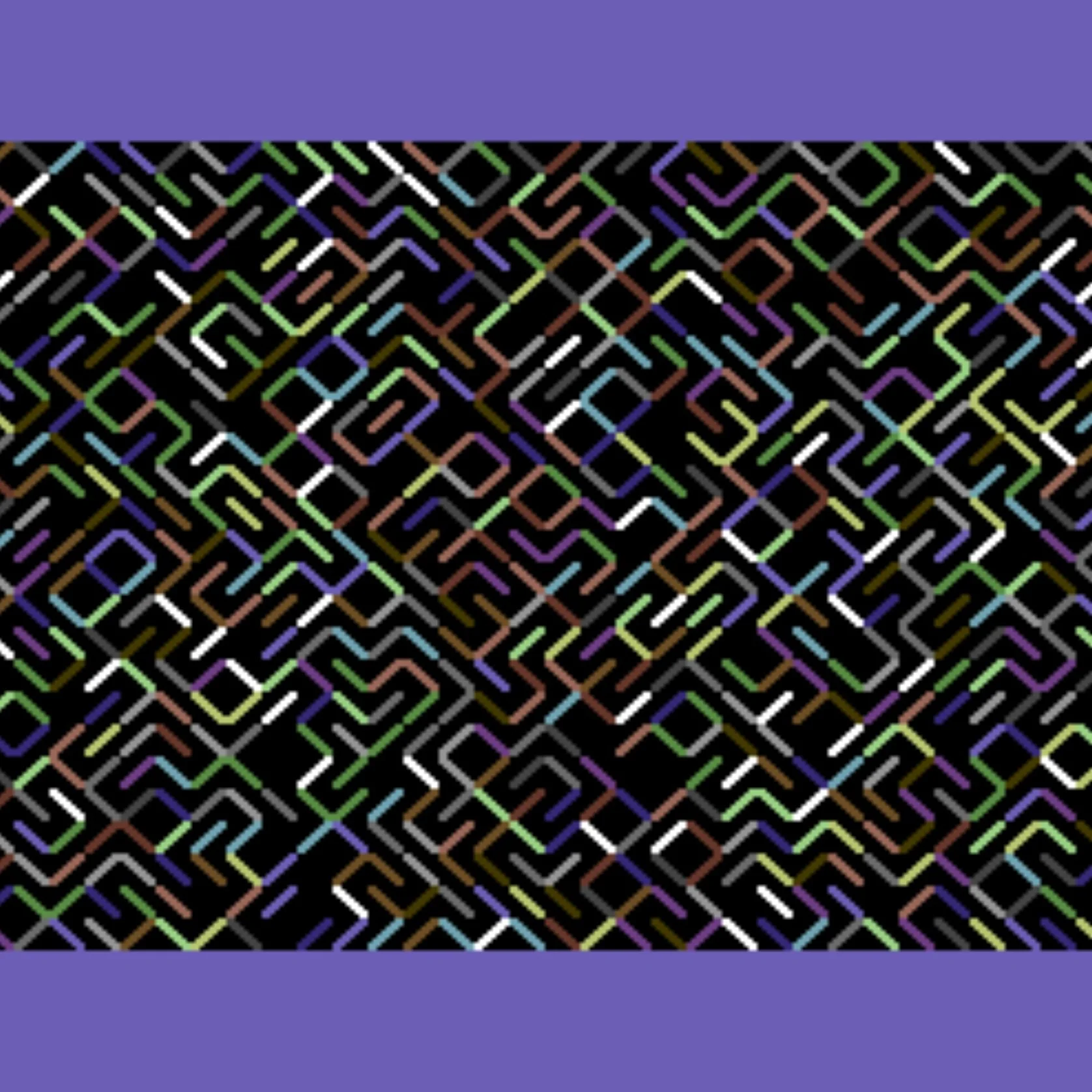The Human Experience of 10 PRINT:
One of the most impactful papers I have ever read was Bruno Latour’s critical analysis—under the satirically Americanized handle of Jim Johnson from Ohio—of a door and the invisible human efforts present and replaced in all technology [1]. It fundamentally changed the way I considered the world around me and to that end my own HCI research. I am fascinated by the meanings and mental models that develop between humans and technology, implicit and explicit, conscious and unconscious, emotional physical and social.
To create this piece I took on the onus of human effort represented by a single line BASIC program from the Commodore 64: 10 PRINT CHR$(205.5+RND(1)); : GOTO 10. This assigns a downward \ or upward / diagonal slash character in each 8x8 pixel attribute cells. Moving from left to right through 40 columns and 24 rows, the 10 PRINT program endlessly—until stopped—fills each of the 1,000 character cells on the C64’s screen. The result is a randomized visual artifact akin to a maze which endlessly scrolls upward off screen until the program is stopped.
I began by modifying the original 10 PRINT program in an online emulator to randomly select one of 16 colors available on the Commodore 64 for each character, as well as set the background to black for no reason other than my own flair for vibrant multi-color aesthetics. Then I collected a set of acrylic paints which felt as near identical a palette as I could assemble. I used an old 48x48” canvas with an unfinished painting and applied a base layer of matte cobalt to evoke the light blue color ($06) of the C64 screen border. In the center I laid out a black 40x24” rectangle and set down a grid of one thousand 1x1” squares. With the canvas primed I then poured all of my 16 colors into containers labeled with the colors corresponding number (in the order they appear in the C64 index) and dipped a brush into each.
Beginning with the top left most square, I rolled a 16-sided die to select a color, picked up the corresponding brush, and flipped a coin to determine the direction of the line (heads = \ and tails = /). Corner to corner I drew my brush in a diagonal stroke as cleanly as possible.
I repeated this 40 times for each of the 24 rows, moving left to right through each cell. Where a computer would effortlessly execute the 10 PRINT program, my body shuddered and shook, painting each stroke in fits and starts as waves of energy pushed me forward before subsiding, slowing my brush. The canvas was so large that for each stroke I shuffled slightly to the right in order to keep my brush in front of me. I began in a standing position but as I moved down to lower rows I had to crunch, squat, and eventually sit on the floor. My arm grew sore and my hand cramped from the repetitive motion gripping the brush, my back ached and spasmed, and my legs prickled with numbness. Despite my bodies protestations, and to spite the painless way the Commodore 64—now my rival and competitor—drove forward rhythmically line by line, I pushed on. This wasn’t a race but rather a test of my endurance, will, and stubbornness.
In the end, what the Commodore 64 accomplished in a mere 40 seconds took me 8 full hours. My family was confused by my asinine antics that had wasted an entire family Sunday. My body hurt that night. My sciatic nerve twisted muscle spasms down my left leg reminding me of the herniated L5-S1 disc from a weight lifting injury years prior. And to top it off, my efforts were imperfect. My strokes wavered in thickness and straightness, growing more blobular throughout. Sometimes I selected the incorrect color. And the grid I laid down warped in sizes throughout shifting down and to the right, an artifact of my dysgraphia I suppose. When I stepped back to reflect I had to consider; was this worth it? Was my static rendition of 10 PRINT CHR$(205.5+RND(1)); : GOTO 10 seven-hundred and twenty times better than the endlessly shifting C64 screen of the same?
[1] Johnson, J. (1988). Mixing humans and nonhumans together: The sociology of a door-closer. Social problems, 35(3), 298-310.Screen capture of the 10 PRINT program running on an online C64 emulator.
Time to fill all attribute cells: 40 seconds.
Mixed media human execution of the 10 PRINT program, on a 48x48” canvas.
Time to fill all grid cells: 8 hours.
